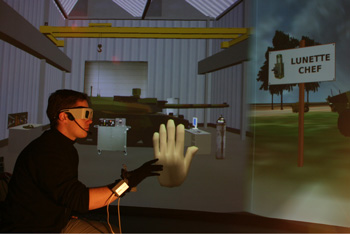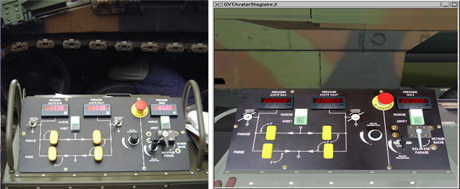by Stéphanie Gerbaud, Bruno Arnaldi and Jacques Tisseau
While the use of real equipment for training in maintenance procedures imposes many constraints, these can be alleviated by the use of virtual reality. The GVT (General Virtual Training) project, developed in a research-industry collaboration, provides a full platform that can be used to build virtual training environments.
The GVT project was born in 2001, from a research-industry collaboration between three French partners: IRISA and CERV laboratories and Nexter-Group (previously Giat-Industries). This last partner, an important company, was stimulated by the need to train people in the maintenance of sensitive military equipment such as the Leclerc Tank. Virtual reality has many advantages when applied to training: a reduction in cost (eg no need to immobilize equipment), no risk (for trainees as well as for the equipment), control of pedagogical situations, and easy monitoring of the trainees' activity. The GVT project was therefore created to provide a platform upon which virtual environments for training in maintenance procedures could be built.
GVT is now an operational multi-user application: in a typical training session, a trainer supervises several trainees. Each trainee has a computer, and trains alone on one of the available procedures. The trainees and the trainer don't need to be co-located; they simply need to be on a common network. Furthermore, different hardware configurations are available: from a full immersive room to a laptop or desktop computer. The peripherals used vary with the hardware configuration, but the software remains the same.
GVT has been designed for procedural training, not to test basic technical knowledge. We assume that the trainees already have a certain level of familiarity with the maintenance activity (eg how to press a button or how to use a screw), and do not ask them to simulate such basic actions. Instead, we use some visual metaphors: when the user wants to interact with an object, he simply selects it (using a mouse or a data glove associated with a position sensor) and a contextual menu appears. In this menu, icons represent possible interactions between this object and the user. The trainee can also access a 2D interface in order to change point of view or to ask for help.

Trainers have a special interface that enables the supervision of trainees. They can monitor their activities (by viewing progression through the procedure, or the number of errors made), communicate with them, and intervene in the environment (eg to show a specific object, or to trigger a hindering noise).
The actual kernel of our platform is divided into three elements that rely on innovative models proposed by IRISA (LORA and STORM models) and by CERV (for differentiated pedagogy).
A Behaviour Engine
The virtual world is composed of behavioural objects modelled with STORM (Simulation and Training Object-Relation Model). These objects are endowed with abilities which enable them to interact with other compatible objects. The behaviour engine manages these complex interactions, and is also used to determine what interactions are possible in the environment.
A Scenario Engine
This engine is used to determine the next steps of the procedure for a trainee, and its state evolves as the trainee achieves certain actions. The scenario is written in the LORA language (Language for Object-Relation Application), the graphical version of which is inspired by Graphcet, and which makes the writing of complex procedures possible.
A Pedagogical Engine
This engine, employed to assist the trainer, uses the two engines above to decide what the trainee is allowed to do. It adapts its reactions to the trainee and to the pedagogical strategy used. This engine was developed in the CERV laboratory.
These elements have been designed to be generic and reusable. In order to build a virtual environment for training, we must design STORM objects (or reuse existing ones) and specify their abilities, describe the procedure in LORA, and define a pedagogical strategy.

Link:
http://www.gvt-nexter.fr/
Please contact:
Bruno Arnaldi
IRISA, France
Tel: +33 2 99 84 72 61
E-mail: Bruno.Arnaldi![]() irisa.fr
irisa.fr









